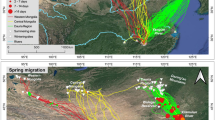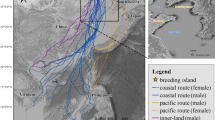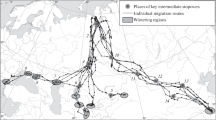Abstract
The Great Bustard (Otis tarda) holds the distinction of the heaviest bird to undertake migration as well as the greatest degree of sexual size dimorphism among living birds. Though the migration of the species has been widely discussed in the literature, researchers know little about the migration patterns of the subspecies in Asia (Otis tarda dybowskii), especially the males. In 2018 and 2019, we captured six O. t. dybowskii (five males and one female) at their breeding sites in eastern Mongolia and tagged them with GPS-GSM satellite transmitters. This constitutes the first time that the Great Bustards of the eastern subspecies have been tracked in eastern Mongolia. We found sex differences in migration patterns: males started migration later but arrived earlier than the female in the spring; males had 1/3 of the migration duration and migrated about 1/2 the distance of the female. Additionally, Great Bustards exhibited high fidelity to their breeding, post-breeding, and wintering sites. For conservation, only 22.51% of GPS location fixes of bustards were within protected areas, and less than 5.0% for wintering sites and during migration. Within two years, half of the Great Bustards we tracked died at their wintering sites or during migration. We recommend establishing more protected areas at wintering sites and rerouting or undergrounding powerlines in areas where Great Bustards are densely distributed to eliminate collisions.
Zuammenfassung
Zugmuster und Schutzstatus der Asiatischen Großtrappe ( Otis tarda dybowskii ) in Nordostasien.
Die Großtrappe (Otis tarda) ist der schwerste Zugvogel und weist in der Körpergröße den größten Geschlechtsdimorphismus unter den heutzutage lebenden Vögeln auf. Zwar wird der Zug dieser Art in der Literatur ausführlich diskutiert, aber man weiß nur wenig über die Zugmuster der Unterart in Asien (Otis tarda dybowskii), vor allem der Männchen. 2018 und 2019 fingen wir sechs O. t. dybowskii (fünf Männchen und ein Weibchen) an ihren Brutplätzen in der östlichen Mongolei und versahen sie mit GPS-GSM-Satellitensendern. Dies war das erste Mal, dass die Großtrappen der östlichen Unterart in der östlichen Mongolei nachverfolgt wurden. Wir stellten geschlechtsspezifische Unterschiede in den Zugmustern fest: Männchen begannen ihre Wanderung später, kamen aber früher als die Weibchen im Frühjahr an; Männchen zogen ein Drittel der Zugzeit und legten etwa die Hälfte der Strecke der Weibchen zurück. Außerdem zeigten die Großtrappen eine große Standorttreue zu ihren Brut-, Aufzucht- und Überwinterungsgebieten. Zum Schutz der Trappen wurden innerhalb von Schutzgebieten nur 22,51% der GPS-Ortungen vorgenommen und in den Winterquartieren und während des Zugs weniger als 5,0%. Die Hälfte der von uns nachverfolgten Großtrappen starb innerhalb von zwei Jahren in ihren Überwinterungsgebieten oder auf dem Zug. Wir empfehlen, in den Überwinterungsgebieten mehr Schutzgebiete einzurichten und Stromleitungen in Gebieten, in denen Großtrappen stark vertreten sind, umzuleiten oder unterirdisch zu verlegen, um Kollisionen zu vermeiden.







Similar content being viewed by others
Data availability
The datasets generated during and/or analysed during the current study are not publicly available for protecting the vulnerable eastern subspecies of Great Bustard, but are stored at Movebank (www.movebank.org) in the study “Great Bustard (Otis tarda dybowskii) in Northeast Asia” (Movebank Study ID: 2225327907) and can be made available by the author upon reasonable request.
Code availability
The analyses generated during the current study are available on reasonable request.
References
Alonso JC (2014) The great bustard: past, present and future of a globally threatened species. Ornis Hung 22:1–13. https://doi.org/10.2478/orhu-2014-0014
Alonso JC, Palacín C (2022) Alarming decline of the Great Bustard Otis tarda world population over the last two decades. Bird Conserv Int. https://doi.org/10.1017/s095927092200003x
Alonso JC, Alonso JA, Muñoz-Pulido R (1994) Mitigation of bird collisions with transmission lines through groundwire marking. Biol Conserv 67:129–134. https://doi.org/10.1016/0006-3207(94)90358-1
Alonso JC, Morales MB, Alonso JA (2000) Partial migration, and lek and nesting area fidelity in female great bustards. The Condor 102:127–136. https://doi.org/10.1093/condor/102.1.127
Alonso JC, Palacín C, Alonso JA, Martín CA (2009a) Post-breeding migration in male great bustards: low tolerance of the heaviest Palaearctic bird to summer heat. Behav Ecol Sociobiol 63:1705–1715. https://doi.org/10.1007/s00265-009-0783-9
Alonso JC, Magaña M, Alonso JA, Palacín C, Martín CA, Martin B (2009b) The most extreme sexual size dimorphism among birds: allometry, selection, and early juvenile development in the great bustard (Otis tarda). Auk 126:657–665. https://doi.org/10.1525/auk.2009.08233
Alonso JC, Álvarez-Martínez JM, Palacín C (2012) Leks in ground-displaying birds: hotspots or safe places? Behav Ecol 23:491–501. https://doi.org/10.1093/beheco/arr215
Briedis M, Bauer S, Adamik P, Alves JA, Costa JS, Emmenegger T, Gustafsson L, Kolecek J, Liechti F, Meier CM, Prochazka P, Hahn S (2019) A full annual perspective on sex-biased migration timing in long-distance migratory birds. Proc R Soc B 286:20182821. https://doi.org/10.1098/rspb.2018.2821
Collar NJ, Baral HS, Batbayar N, Bhardwaj GS, Brahma N, Burnside RJ, Choudhury AU, Combreau O, Dolman PM, Donald PF, Dutta S, Gadhavi D, Gore K, Goroshko OA, Hong C, Jathar GA, Jha RRS, Jhala YV, Koshkin MA, Lahkar BP, Liu G, Mahood SP, Morales MB, Narwade SS, Natsagdorj T, Nefedov AA, Silva JP, Thakuri JJ, Wang M, Zhang Y, Kessler AE (2017) Averting the extinction of bustards in Asia. Forktail 33:1–26
Coppack T, Pulido F (2009) Proximate control and adaptive potential of protandrous migration in birds. Integr Comp Biol 49:493–506. https://doi.org/10.1093/icb/icp029
Dierschke V, Mendel B, Schmaljohann H (2004) Differential timing of spring migration in northern wheatears Oenanthe oenanthe: hurried males or weak females? Behav Ecol Sociobiol 57:470–480. https://doi.org/10.1007/s00265-004-0872-8
Fieberg J, Kochanny C (2005) Quantifying home-range overlap: the importance of the utilization distribution. J Wildlife Manag 69:1346–1359
Fusani L, Gwinner E (2005) Melatonin and nocturnal migration. Ann N Y Acad Sci 1046:264–270. https://doi.org/10.1196/annals.1343.024
Gu Z, Pan S, Lin Z, Hu L, Dai X, Chang J, Xue Y, Su H, Long J, Sun M, Ganusevich S, Sokolov V, Sokolov A, Pokrovsky I, Ji F, Bruford MW, Dixon A, Zhan X (2021) Climate-driven flyway changes and memory-based long-distance migration. Nature 591:259–264. https://doi.org/10.1038/s41586-021-03265-0
IUCN (2017) Otis tarda. The IUCN Red List of Threatened Species 2017. pp e.T22691900A119044104
Janss GFE (2000) Avian mortality from power lines: a morphologic approach of a species-specific mortality. Biol Conserv 95:353–359. https://doi.org/10.1016/S0006-3207(00)00021-5
Kessler AE (2015) Asian great bustards: From conservation biology to sustainable grassland development. PhD thesis, Arizona State University, Arizona
Kessler AE, Smith AT (2014) The status of the great bustard (Otis tarda tarda) in Central Asia: from the Caspian Sea to the Altai. Aquila 121:115–132
Kessler AE, Batbayar N, Natsagdorj T, Batsuur’ D, Smith AT (2013) Satellite telemetry reveals long-distance migration in the Asian great bustard Otis tarda dybowskii. J Avian Biol 44:311–320. https://doi.org/10.1111/j.1600-048X.2013.00072.x
Ketterson ED (1976) Geographic variation and its climatic correlates in the sex ratio of eastern-wintering dark-eyed juncos (Junco Hyemalis Hyemalis). Ecology 57:679–693. https://doi.org/10.2307/1936182
Kissner K, Weatherhead PJ, Francis CM (2003) Sexual size dimorphism and timing of spring migration in birds. J Evol Biol 16:154–162. https://doi.org/10.1046/j.1420-9101.2003.00479.x
Lang X (2021) Differences in migration of adult and subadult white-naped cranes (Antigone vipio) based on satellite tracking data. Masters thesis, Beijing Forestry University, China
Lank DB (1989) Why fly by night? Inferences from tidally-induced migratory departures of sandpipers. J Field Ornithol 60:154–161
Limiñana R, Romero M, Mellone UGO, Urios V (2012) Mapping the migratory routes and wintering areas of lesser kestrels Falco naumanni: new insights from satellite telemetry. Ibis 154:389–399. https://doi.org/10.1111/j.1474-919X.2011.01210.x
Liu G, Hu X, Shafer ABA, Gong M, Han M, Yu C, Zhou J, Bai J, Meng D, Yu G, Dang D (2017) Genetic structure and population history of wintering Asian great bustard (Otis tarda dybowskii) in China: implications for conservation. J Ornithol 158:761–772. https://doi.org/10.1007/s10336-017-1448-5
Marques AT, Martins RC, Silva JP, Palmeirim JM, Moreira F (2020) Power line routing and configuration as major drivers of collision risk in two bustard species. Oryx 55:442–451. https://doi.org/10.1017/s0030605319000292
Martin G (1990) Birds by night. T & AD Poyser Ltd, London
Martínez C (2000) Daily activity patterns of great bustards Otis tarda. Ardeola 47:57–68
Mccabe RA, Goodrich LJ, Barber DR, Master TL, Watson JL, Bayne EM, Harrison A-L, Marra PP, Bildstein KL (2020) Satellite tracking reveals age and origin differences in migration ecology of two populations of broad-winged hawks (Buteo platypterus). Wilson J Ornithol 132:1–14. https://doi.org/10.1676/1559-4491-132.1.1
Mi C, Falk H, Guo Y (2016) Climate change enlarges China’s great bustards’ (Otis tarda dybowskii) suitable wintering distribution in the 21st century. PeerJ 4:e1630. https://doi.org/10.7717/peerj.1630
Mi C, Huettmann F, Sun R, Guo Y (2017) Combining occurrence and abundance distribution models for the conservation of the Great Bustard. PeerJ 5:e4160. https://doi.org/10.7717/peerj.4160
Mi C, Møller AP, Guo Y (2018) Annual spatio-temporal migration patterns of hooded cranes wintering in Izumi based on satellite tracking and their implications for conservation. Avian Res 9:23. https://doi.org/10.1186/s40657-018-0114-9
Morales MB, Martín CA (2002) Otis tarda great bustard. BWP Update 4:217–232
Morales MB, Alonso JC, Alonso JA, Martin E (2000) Migration patterns in male great bustards (Otis tarda). Auk 117:493–498. https://doi.org/10.1093/auk/117.2.493
Morales MB, Alonso J, Martín C, Martín E, Alonso J (2003) Male sexual display and attractiveness in the great bustard Otis tarda: the role of body condition. J Ethol 21:51–56. https://doi.org/10.1007/s10164-002-0076-5
Myers JP (1981) A test of three hypotheses for latitudinal segregation of the sexes in wintering birds. Can J Zool 59:1527–1534. https://doi.org/10.1139/z81-207
Natsagdorj T (2001) The great bustard (Otis tarda dybowskii L.) in Mongolia. Institute of Biology, Mongolian Academy of Science’s Proceedings, Ulaanbaatar, Mongolia
Newton I (2008) The migration ecology of birds. Academic Press, London
Palacín C, Alonso JC, Alonso JA, Martín CA, Magaña M, Martin B (2009) Differential migration by sex in the great bustard: possible consequences of an extreme sexual size dimorphism. Ethology 115:617–626. https://doi.org/10.1111/j.1439-0310.2009.01647.x
R Core Team (2021) R: a language and environment for statistical computing. R Foundation for Statistical Computing, Vienna
Raab R, Julius E, Greis LM, Spakovszky P (2014) Endangering factors and their effect on adult great bustards (Otis tarda)—conservation efforts in the Austrian LIFE and LIFE+ projects. Aquila 121:49–63
Schmaljohann H (2018) Proximate mechanisms affecting seasonal differences in migration speed of avian species. Sci Rep 8:4106. https://doi.org/10.1038/s41598-018-22421-7
Schmaljohann H, Meier C, Arlt D, Bairlein F, Van Oosten H, Morbey YE, Åkesson S, Buchmann M, Chernetsov N, Desaever R, Elliott J, Hellström M, Liechti F, López A, Middleton J, Ottosson U, Pärt T, Spina F, Eikenaar C (2016) Proximate causes of avian protandry differ between subspecies with contrasting migration challenges. Behav Ecol 27:321–331. https://doi.org/10.1093/beheco/arv160
Scott JM, Davis FW, Csuti B, Noss R, Butterfield B, Groves C, Anderson H, Caicco SL, Derchia F, Edwards TCJ, Ulliman J, Wright RG (1993) Gap analysis: a geographic approach to protection of biological diversity. Wildlife Monogr 123:1–41
Shaw JM, Reid TA, Gibbons BK, Pretorius M, Jenkins AR, Visagie R, Michael MD, Ryan PG (2021) A large-scale experiment demonstrates that line marking reduces power line collision mortality for large terrestrial birds, but not bustards, in the Karoo, South Africa. Condor 123:1–10. https://doi.org/10.1093/ornithapp/duaa067/6124711
Signer J, Fieberg J, Avgar T (2019) Animal movement tools (amt): R package for managing tracking data and conducting habitat selection analyses. Ecol Evol 9:880–890. https://doi.org/10.1002/ece3.4823
Streich WJ, Litzbarski H, Ludwig B, Ludwig S (2005) What triggers facultative winter migration of great bustard (Otis tarda) in central Europe? Eur J Wildl Res 52:48–53. https://doi.org/10.1007/s10344-005-0007-1
Tourenq C, Combreau O, Lawrence M, Launay F (2004) Migration patterns of four Asian houbara Chlamydotis macqueenii wintering in the Cholistan Desert, Punjab. Pakistan Bird Conserv Int. https://doi.org/10.1017/s0959270904000012
UNEP-WCMC, IUCN (2021) Protected planet: the world database on protected areas (WDPA) Cambridge, UK. https://www.protectedplanet.net. Accessed 4 Dec 2021
Wang Y, Mi C, Guo Y (2020) Satellite tracking reveals a new migration route of black-necked cranes (Grus nigricollis) in Qinghai-Tibet Plateau. PeerJ 8:e9715. https://doi.org/10.7717/peerj.9715
Watzke H (2007) Results from satellite telemetry of great bustards in the Saratov region of Russia. Bustard Stud 6:83–98
Acknowledgements
We thank Yun yan, Xilin Gol League Forest Public Security for helping us with fieldwork and Professor Xinhai Li for guidance in the statistical calculation. We thank the long-term support of the National Forestry and Grassland Administration. We thank Dr. Tim Treuer at Princeton University for his assistance with the English language and grammatical editing. Special thanks to our hardworking driver Bundaa and local herder family Khurelee in the Ugtam area.
Funding
This work was supported by the National Natural Science Foundation of China (No. 31770573).
Author information
Authors and Affiliations
Contributions
YG conceived the project idea and contributed substantial materials, resources, and funding. GP, AG, BE, OT, DK, ZW and YG carried out fieldwork. YW and CM analysed and visualized the data. YW drafted the manuscript with the support of GP, CM and YG. All authors read and approved the final manuscript.
Corresponding author
Ethics declarations
Conflict of interest
The authors declare that they have no competing interests.
Ethical approval
The study was performed under the licences of the Ministry of Nature, Environment and Tourism of Mongolia (Ethics approval number: 10).
Additional information
Communicated by N. Chernetsov.
Publisher's Note
Springer Nature remains neutral with regard to jurisdictional claims in published maps and institutional affiliations.
Supplementary Information
Below is the link to the electronic supplementary material.
Rights and permissions
Springer Nature or its licensor (e.g. a society or other partner) holds exclusive rights to this article under a publishing agreement with the author(s) or other rightsholder(s); author self-archiving of the accepted manuscript version of this article is solely governed by the terms of such publishing agreement and applicable law.
About this article
Cite this article
Wang, Y., Purev-Ochir, G., Gungaa, A. et al. Migration patterns and conservation status of Asian Great Bustard (Otis tarda dybowskii) in northeast Asia. J Ornithol 164, 341–352 (2023). https://doi.org/10.1007/s10336-022-02030-y
Received:
Accepted:
Published:
Issue Date:
DOI: https://doi.org/10.1007/s10336-022-02030-y




